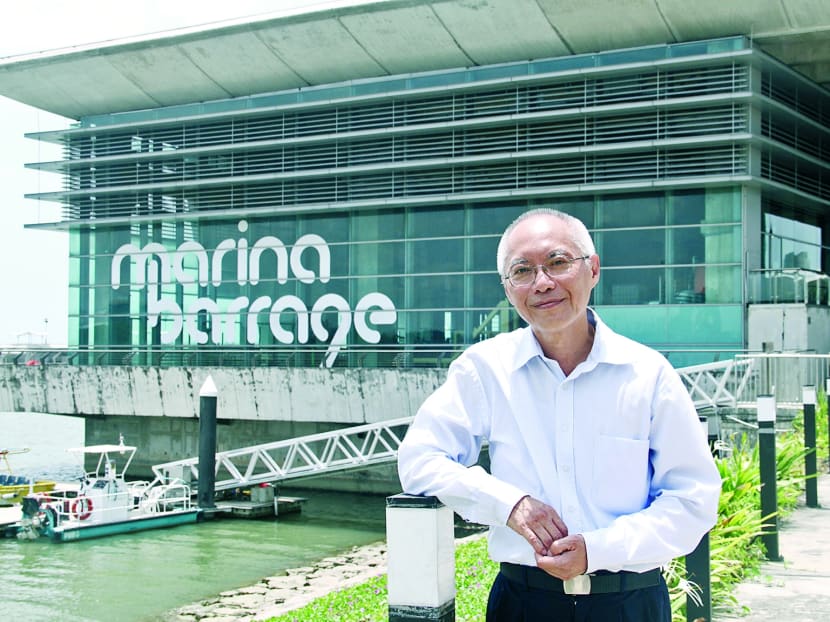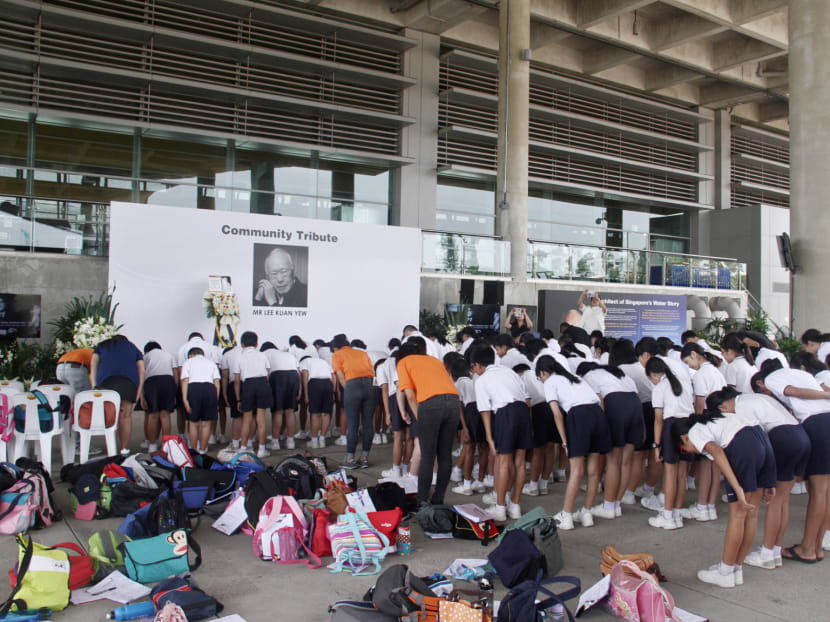Foresight brought water projects to fruition
SINGAPORE — Decked in his usual white short-sleeved shirt, tailored cotton pants and track shoes, Mr Lee Kuan Yew would take in the sights and sounds of the Marina Barrage surroundings every Sunday evening, getting off his buggy occasionally to stare quietly at the skyscraper-dotted Singapore skyline or the deep blue waters stretching beyond the Marina Channel.


SINGAPORE — Decked in his usual white short-sleeved shirt, tailored cotton pants and track shoes, Mr Lee Kuan Yew would take in the sights and sounds of the Marina Barrage surroundings every Sunday evening, getting off his buggy occasionally to stare quietly at the skyscraper-dotted Singapore skyline or the deep blue waters stretching beyond the Marina Channel.
“He (Mr Lee) was just like (someone) looking at a baby grow — a baby born out of a vision that he had made 20 years ago and (he) saw that come to fruition,” recalled Mr Yap Kheng Guan, former director in charge of the Marina Barrage project, of Mr Lee’s Sunday visits that occurred between 2008 and 2009.
In 1987, after the big clean-up of the then polluted Singapore River, Mr Lee famously challenged the Government to build a dam across the Marina Channel to create a freshwater lake.
Today, that “baby” is not only a lake, but also part of a scheme to alleviate flooding in low-lying areas and has become a popular recreational spot for Singaporeans.
Showing the foresight that has led many to call Mr Lee the “architect of Singapore’s water story”, the then Prime Minister proclaimed in 1987 that technology would be ready in two decades for a dam to be built across the Marina Channel.
Mr Lee said: “In 20 years, it is possible that there could be breakthroughs in technology, both anti-pollution and filtration. Then, we can dam up or put a barrage at the mouth of the marina, the neck that joins the sea, and we will have a huge freshwater lake.”
Mr Yap, 63, recalled that, at that time, while engineers like him knew such breakthroughs were possible, they would never have thought of setting a time frame.
“For him (Mr Lee) to pin down a time frame, it really requires courage and vision,” said Mr Yap, who retired from national water agency PUB in 2011.
“He showed us engineers the way — that we need to look beyond the conventional ... to be bold in our designs, aspirations ... He taught me that difficulties might appear to be insurmountable but, if we apply our hearts and minds to it, we can overcome.”
True to Mr Lee’s prediction, advancements in membrane technology enabled feats such as reverse osmosis to be achieved in the 1990s, paving the way for the launch of Singapore’s high-grade reclaimed water, NEWater, in 2003.
In 2005, Mr Lee, who was by then Minister Mentor, kicked off construction work for the S$226 million Marina Barrage. Three years later, the barrage — Singapore’s 15th reservoir — was opened in the heart of the city.
Mr Yap told TODAY the two-decade-long period to realise Mr Lee’s Marina Barrage vision was a “reasonable” timeline, with plenty of behind-the-scenes action taking place during that time. These included keeping track of technological advancements and running laboratory tests and pilot projects, with Mr Lee receiving updates on the various water projects coming through, Mr Yap added.
He attributed the efforts to realise Mr Lee’s Marina Barrage vision over 20 years to the late leader’s emphasis on the need to build up Singapore’s water resilience.
Mr Lee had never forgotten the threat made by former Malaysian Prime Minister Tunku Abdul Rahman, relayed to Mr Lee by the British, that “if Singapore doesn’t do what I want, I’ll switch off the water supply”.
Also, because of his experience in World War II, during which Japanese soldiers bombed pipes carrying water from Johor in 1942, Mr Lee was determined from the start to ensure Singapore would be self-sufficient in its water supply.
The late leader has also been credited for being the inspiration behind Singapore’s “four big national taps”: Water from local catchment, supply from Malaysia, desalinated seawater as well as reclaimed/recycled water from local waste water (NEWater).
His preoccupation with water resilience continued even in 2008, long after Singapore had made the transition from Third World to First.
At a dialogue session with an international audience, Mr Lee said: “This (the water issue) dominated every other policy. Every other policy had to bend at the knees for water survival.”
Foreign experts were also impressed by Mr Lee’s deep knowledge of water technology and policies, said Mr Yap, who related how the late leader had compared Marina Barrage’s set-up to the Dutch dam systems.
While Marina Barrage has often been cited as a fine example of integrating engineering with nature, its popularity as a favourite weekend spot for many families must have brought much cheer to Mr Lee.
Mr Yap recalled that during Mr Lee’s half-hour Sunday visits to the area in the late 2000s, there was a scene that would often bring a smile to the former Prime Minister’s face.
“There was a seafood restaurant ... At around 6 o’clock, we had almost wrapped up the visit and saw many families having steamboat. You could see his proud smile upon seeing people coming to enjoy themselves,” said Mr Yap, who drove the buggy for Mr Lee during his weekly visits.
“What really pleased him was seeing happy faces, families and kids having a good time and flying kites,” he added.
Mr Lee’s visit to the area was an almost regular Sunday affair, especially during the initial years of the Marina Barrage’s opening in 2008. He would arrive at between 4pm and 5pm, when the relentless heat had given way to cooler winds.
The former Prime Minister had a deep sense of curiosity, Mr Yap said. Like an inquisitive child, Mr Lee would ask questions, ranging from the type of grass used at the Marina Barrage’s rooftop to the different shades of blue between the waters in the open sea, compared with those in the catchment area.
But he would also offer nuggets of wisdom on the most unexpected topic. “He was sharing his knowledge about how grass grew, how you should maintain it, the type of soil to use ... it was almost as if this was a man from NParks (National Parks Board),” quipped Mr Yap. “This is a man who knew all the big things around the world. Yet, he (also) knew the minute details of how grass should be grown.”
For Mr Yap, the memory of hosting Mr Lee for the first time is also deeply etched in his mind. Feeling nervous, Mr Yap had driven the buggy at what he thought was an acceptable speed and did not notice Mr Lee’s security officers half-running to catch up with them. “Mr Lee told me, ‘Slow down, slow down, they have to run after you,’” he said.
In his later years, as his health declined and his steps grew slower, Mr Lee’s visits to Marina Barrage became less frequent. But the questions never stopped when he visited. “We were looking at the sea ... He asked me why there are so many ships out there,” said Mr Yap. “I said, ‘Sir, I don’t know.’ And he laughed.”









